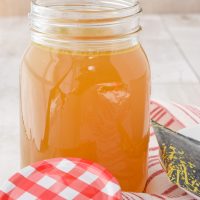Print


Homemade Turkey Stock Recipe
Turkey carcass, combined with a blend of herbs and spices and aromatic and flavorful vegetables, makes healthy and tasty homemade turkey stock
Ingredients
- 1 Carcass (with some meat left on it) from 7-9 lb roasted turkey
- 2 lbs fresh cut up turkey pieces
- 1 tsp mixed peppercorns
- 1 tsp dried rosemary
- 1/2 tbsp dried parsley
- 1 tsp dried thyme
- 1 tsp dried dill
- 1 tsp dried sage
- 1 tsp dried basil
- 1/2 tsp dried coriander
- 1 tsp dried summer savory
- 3 whole cardamom pods
- 6 whole cloves
- 4 whole allspice
- 1 whole star anise pod
- 16 cups cold water
- 1 tbsp cider vinegar
- 3 bay leaves
- 1 1/2 - 2 tsp Kosher salt, or to taste
- 1 large onion, skin on, halved
- 1 large leek, white and pale green parts only, sliced in half lengthwise and crosswise
- 2 large carrots, washed, unpeeled, halved lengthwise and chopped into 3” chunks
- 5 celery ribs with leaves+ celery stalk base (celery ribs cut into 3" chunks)
- 1 head garlic, halved crosswise, skins on the cloves
- 3 slices rutabaga, about ¾” thick, peeled and sliced in half
- 2 large parsnips, washed, unpeeled, halved lengthwise and chopped into 3” chunks
- 6-8 mushrooms (button or cremini), halved (optional)
Instructions
-
Preheat oven to 425°F. Brush thin coating of cooking oil over raw turkey pieces. Place turkey pieces in greased baking pan. Roast, uncovered (or loosely tented with tin foil to avoid splatters in oven) for about 25-35 minutes, turning with tongs after 15 minutes. Remove turkey pieces from oven and transfer to heatproof dish. Using a large wooden spoon, scrape up any brown bits left in roasting pan. Mix with approximately ½ - ¾ cup of warm water. Heat over medium heat, stirring to prevent burning.
-
Place turkey carcass and turkey pieces into large stock pot along with the browned liquid from the roasted turkey pieces.
-
Using a small 8” square of double cheese cloth, gather the dried herbs and spices together in the center and tie up cheesecloth to make a bouquet garni. Drop the sachet in to the stock pot. Add the cold water, vinegar, bay leaves, sea salt, onion, leek, carrots, celery root and ribs, garlic head, rutabaga, parsnips, and mushrooms (if using).
-
Bring mixture to just below the boiling point over medium high heat. DO NOT BOIL. Reduce heat to a low simmer (liquid temperature should reach and remain around the 200°F point) and let stock simmer, uncovered, for 5-6 hours. If liquid evaporates too much and too quickly, reduce the heat and add a bit more water (e.g., 1 cup, or so). Periodically, skim the fat, as it forms, from the surface of the stock as it simmers. Do not stir mixture as it simmers as this may create a cloudy stock.
-
Prepare a large colander with a double layer of damp cheesecloth. Place colander over large clean stock pot and pour the stock/broth mixture into the colander to strain it. Discard the solids – i.e., bones, vegetables, and bouquet garni.
-
Wash original stock pot in which the stock was made. Line a fine mesh sieve with a new piece of double layer of damp cheesecloth and place over the clean stock pot. Pour stock through sieve to remove any remaining solids, stray herbs, etc.
-
Place stockpot containing the strained stock in large sink filled with ice water to cool the stock quickly. Remove and discard any solidified fat. Place strained stock in refrigerator for several hours, or overnight, to chill completely then remove any remaining solidified fat from the chilled stock.
-
Use stock immediately or store, covered, in refrigerator for up to 2 days. Alternatively, pour stock into freezer-safe containers of desired size and freeze for future use. Yield: Apx. 16 cups (depending on amount of evaporation and reduction that has occurred).
Recipe Notes
Note 1: Strained stock may be reheated over medium-low heat and reduced to one-half. This will yield a stronger flavored and more concentrated product but, naturally, there will be less quantity.
Note 2: Straining the stock twice through a cheesecloth-lined colander/fine mesh sieve will yield a clearer stock, free of any impurities.
Note 3: This recipe is scalable – if you have a smaller turkey frame, reduce quantities of ingredients; if it is a larger frame, increase quantities proportionately.
Be sure to read the accompanying blog post to this recipe as it contains additional information and tips on making turkey stock.
[Copyright My Island Bistro Kitchen]